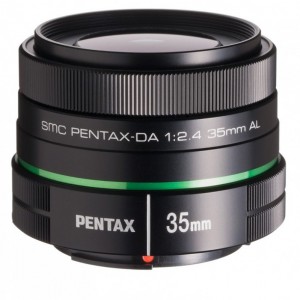Pentax-DA 35mm F2.4 AL
Distortion
Like most lenses, particularly those venturing towards the wider end of the focal length spectrum, distortion is usually present in some way, shape, or form. Coming in several variations -- "barrel" or "pincushion" are the most common ones and the types we'll be focusing on -- distortion in the context of photography is an optical aberration (deformity) that results in bending and deforming straight lines in a scene so they appear to be curved or slanted in the resulting image.
EDITORIAL NOTE: Because this lens is aimed towards not only enthusiasts but "I-just-got-a-DSLR-for-Christmas-and-I-have-no-idea-what-I'm-doing beginners" as well, we wanted to give an explanation of what distortion is and what it looks like. For those whom this mini-tutorial is not needed, please scroll down and continue to the actual testing and examples of distortion as produced by this lens.
Distortion Explained and Generic Examples
To illustrate what this actually looks like in practice, let's take a look at the following series of grids, which you can click on to view a much larger verson:
 | ||
| Barrel Distortion | No Distortion | Pincushion Distortion |
Barrel Distortion
Barrel distortion is aptly named because its straight lines (either horizontal or vertical) bend in such a manner that they give off the impression they are "bulging" towards you, similar to the way a barrel would look from the side. Notice how the lines through the very center of the image are straight yet increasingly distort the further they are from the center. This is because they are aligned with the optical axis of the lens whereas the edges have reduced magnification. Barrel distortion is most prevalent in wide angle lenses because the field of view is wider than the size of the image sensor, causing the edges to be "squeezed in," and hence why the effect is much more pronounced on the super wide focal lengths (16mm and below) on APS-C sized sensors as opposed to their equivalent field of views on 35mm Full Frame (24mm and below). Also, fisheyes are the kings of barrel disortion, and it's their purposeful implementation of it through an optical design that intentionally distorts in this manner that allows for such a mind-bending wide field of view.
Pincushion Distortion
The exact opposite of barrel distortion, straight lines curve upwards in the corners. Common in zoom lenses, especially those with longer focal lengths, it isn't uncommon for superzooms to begin with barrel distortion in their wider focal lengths and then transition to pincushion towards its telephoto end.
While it may seem like all hope is lost, the above examples were exaggerated to clearly see the effect of either distortion. And thanks to modern post processing software, such as Adobe Photoshop, the less of an issue these maladies have become. But of course it's always better to start with the best file possible before your image file ever leaves your memory card. In reality, the actual degree of distortion in any given lens is usually much less, and even the best lenses will exhibit some sort of this deformity, minimized as much as possible thanks to careful attention to optical engineering. The better controlled these lenses are, the more of a premium you'll have to pay for them - both in price as well as bulk.
Back to the crux of this review - how well does this "Plastic Fantastic" hold up in terms of distortion?
Brick Wall Distortion Test
For our controlled "brick wall" test (because what would a lens review be without some good ole masonry), we shot at the lens' fixed focal length of 35mm atop a tripod on a Pentax K-3. Just like on the previous page, the same type of slider is used:


Because the DA 35 AL has a profile built into Lightroom, it was very easy to correct for distortion automatically rather than having to do so manually. Regardless, the change was akin to a +2 change to correct for the very minor barrel distortion.
Real World Distortion Examples
Because the real world isn't just a bunch of brick walls, we wanted to show how distortion might affect you when out and about. Both examples were corrected using the built-in Lightroom profile for the 35mm AL.
Surburban Street Scene


Lake Scene


Like we said, the above two examples were corrected using the correction profiled by the software engineers behind Adobe Lightroom. However, we took a stab at applying a manual correction for each (thus foregoing the Adobe-profiled correction) and found our attempt to favor a slightly weaker adjustment.
Verdict
Pentax's humble 35mm prime does an excellent job of managing distortion, which we didn't expect to be handled so well. It's for this reason, coupled with its high level of sharpness and resolution (more on that on the Sharpness page coming up) at a highly affordable price, that this optic is very popular for creating multi-image panoramas. Here's one such example, created by nine vertical images stitched together by Pentax Forums user manacho2005, of the Dallas, Texas, skyline. Click on the image below for a larger view:



